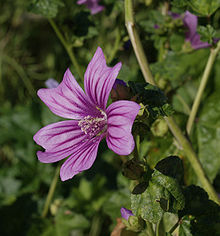- Malva
-
- Malva was an Dacian settlement in present day Romania, where the Roman city of Romula was built. It is an alternative spelling for the Indian region and state Malwa, the pseudonym of Syrian artist Omar Hamdi, and it is the name of a South African sweet pudding.
Malva 
Malva sylvestris Scientific classification Kingdom: Plantae (unranked): Angiosperms (unranked): Eudicots (unranked): Rosids Order: Malvales Family: Malvaceae Subfamily: Malvoideae Tribe: Malveae Genus: Malva
L.Type species M. sylvestris[1] Species About 25–30; see text.
Synonyms Axolopha (DC.) Alef.
Dinacrusa G.Krebs[2]Malva is a genus of about 25–30 species of herbaceous annual, biennial, and perennial plants in the family Malvaceae (of which it is the type genus), one of several closely related genera in the family to bear the common English name mallow. The genus is widespread throughout the temperate, subtropical and tropical regions of Africa, Asia and Europe.[3] The word "mallow" is derived from Old English "malwe", which was imported from Latin "malva", which originated in Ancient Greek μαλάχη (malakhē) meaning "yellow" or Hebrew מַלּוּחַ (malúakh) meaning "salty".[4][5] A number of species, previously considered to belong to Lavatera, have been moved to Malva.
The leaves are alternate, palmately lobed. The flowers are from 0.5–5 cm diameter, with five pink or white petals.
The colour mauve was in 1859 named after the French name for this plant.
Contents
Cultivation and uses
Several species are widely grown as garden flowers, while some are invasive weeds, particularly in the Americas where they are not native.
Many species are edible as leaf vegetables. Known as ebegümeci in Turkish, it is used as vegetable in Turkey in various forms such as stuffing the leaves with bulgur or rice or using the boiled leaves as side dish. Malva verticillata (Chinese: 冬寒菜; pinyin: dōngháncài, Korean: 아욱 auk) is grown on a limited commercial scale in China; when made as a herbal infusion, it is used for its colon cleansing properties and as a weight loss supplement.
Very easily grown, short-lived perennials often grown as ornamental plants. Mild tasting young mallow leaves can be a substitute for lettuce, whereas older leaves are better cooked as a leafy green vegetable. The buds and flowers can be used in salads.
Cultivation is by sowing the seeds directly outdoors in early spring. The seed is easy to collect, and they will often spread themselves by seed.
In Catalonia (Southern Europe) they use the leaves to cure stinging nettles sting.
Bodo tribals in Bodoland, Assam (Northeast India) cultivate a sub-species of malva and use it extensively in their traditional cuisine, although its use is not much known among other people of India.
History
This plant is one of the earliest cited in recorded literature. Horace mentions it in reference to his own diet, which he describes as very simple: "Me pascunt olivae, me cichorea, me malvae" ("As for me, olives, endives, and mallows provide sustenance").[6] Lord Monboddo describes his translation of an ancient epigram that demonstrates malva was planted upon the graves of the ancients, stemming from the belief that the dead could feed on such perfect plants.[7]
Mallow, which grows wild in the Middle East, is widely used as a source of nourishment in wartime and periods of austerity. Known as خبّيزة (khubeza) in Arabic, it is used as the main ingredient in a traditional Arab dish called by the same name; as well as in salads, soups and other dishes by the local Arab people.
Species list
- Malva aegyptia
- Malva aethiopica C.J.S. Davis[8]
- Malva alcea L.—Greater Musk-mallow, Vervain Mallow
- Malva assurgentiflora
- Malva brasiliensis Desr.—Brazilian Mallow
- Malva canariensis
- Malva cathayensis
- Malva cretica
- Malva dendromorpha—Tree Mallow
- Malva hispanica
- Malva microcarpa
- Malva microphylla
- Malva mohileviensis
- Malva moschata L.—Musk-mallow
- Malva neglecta—Dwarf Mallow, Buttonweed, Cheeseplant, Cheeseweed, Common Mallow, Roundleaf Mallow
- Malva nicaeensis All.—French Mallow, Bull Mallow
- Malva pacifica
- Malva parviflora L.—Least Mallow, Cheeseweed, Cheeseweed Mallow, Small-whorl Mallow
- Malva preissiana—Australian Hollyhock
- Malva pseudolavatera
- Malva pusilla—Small Mallow
- Malva qaiseri
- Malva rotundifolia L.—Low Mallow
- Malva stipulacea
- Malva subovata
- Malva sylvestris L.—Common Mallow, High Mallow
- Malva transcaucasica
- Malva tournefortiana
- Malva trifida
- Malva verticillata L.—Chinese Mallow, Cluster Mallow
Sources:[3][9][10][11][12][13][14]
References
- ^ "Malva L.". Index Nominum Genericorum. International Association for Plant Taxonomy. 1996-02-09. http://botany.si.edu/ing/INGsearch.cfm?searchword=Malva. Retrieved 2008-05-09.
- ^ "Malva L.". Germplasm Resources Information Network. United States Department of Agriculture. 2007-03-12. http://www.ars-grin.gov/cgi-bin/npgs/html/genus.pl?7216. Retrieved 2010-02-16.
- ^ a b Malvaceae Info: Malva
- ^ http://www.etymonline.com/index.php?term=mallow
- ^ http://en.wiktionary.org/wiki/malva
- ^ Horace, Odes 31, ver 15, c. 30 BC
- ^ Letter from Monboddo to John Hope, 29 April 1779; reprinted by William Knight 1900 ISBN 1-85506-207-0.
- ^ C.J.S. Davis, Malva aethiopica, a new name for Lavatera abyssinica (Malvaceae): an endemic species of the Ethiopian Highlands, Phytotaxa 13: 56–58 (2010)
- ^ Africal Flowering Plants Database: Malva
- ^ Flora Europaea: Malva
- ^ Flora of Pakistan: Malva
- ^ Flora of China: Malva checklist
- ^ "Malva L.". Integrated Taxonomic Information System. http://www.itis.gov/servlet/SingleRpt/SingleRpt?search_topic=TSN&search_value=21832. Retrieved 9 May 2008.
- ^ UniProt. "Genus Malva". http://beta.uniprot.org/taxonomy/96479. Retrieved 2008-05-09.
External links
 Media related to Malva at Wikimedia Commons
Media related to Malva at Wikimedia Commons  Data related to Malva at WikispeciesCategories:
Data related to Malva at WikispeciesCategories:- Malva
- Lawn weeds
- Leaf vegetables
Wikimedia Foundation. 2010.
